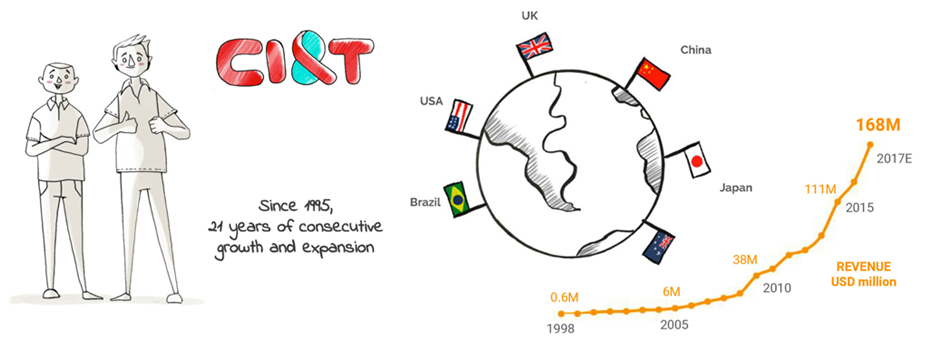Chet: Hi I’m Chet Marchwinski, Communications Director at the Lean Enterprise Institute, and today we’re talking about lean at a tech company, with the founders of CI&T, Cesar Gon and Bruno Guicardi. Gentlemen, thanks for coming and taking time out of your busy schedules to talk about this topic.
What I found pretty unique about your company is that you began your transformation with hoshin kanri, or strategy deployment, as it’s sometimes called. Why did you start there?
Bruno: We realized that if we REALLY want to transform CI&T, we need to start by transforming ourselves as leaders. And after discussing this with the Lean Institute, we decided to pick hoshin kanri, because strategic planning is our main responsibility for the company. So if we started there, it would change our day-to-day jobs and we could start changing ourselves.
Chet: So you had to start changing yourselves too?
Cesar: We already had this belief that people don’t follow advice. So that means they don’t follow the writing on the wall; they prefer to follow examples, and mostly examples by their leaders, right? So when we read all the principles and books and fell in love with lean, at the same time we knew that the change would have to start with us.
Chet: That’s a good place to start, by setting an example for the company. But I’m wondering, since you started with yourselves, how did it go over with your other senior managers?
Bruno: They caught on pretty well. In our first cycle of hoshin kanri, we really had to engage all the senior leadership in the process. So we got a chance to provide some formal training for them on lean principles – A3 thinking and hoshin and so on – and then let them use that practically during the execution of the hoshin. So in some sense, it was a way to speed up studying lean and applying it in real situations. I think it’s working.
Chet: Did you get any pushback on this?
Bruno: Yes, but I think we learned a lot about how to actually push for change. If you take people too far out of their comfort zones they will fight back, and I think that’s human nature. We had to be very gradual. We knew where we wanted to be, and we knew that wouldn’t be overnight; we knew it would take years to cascade down to the team leader level.
It actually took five years. But we asked them to understand the work that their teams were doing, understand the problems happening with their teams, and help their teams actually get out of problems. So we actually started behaving with them the way that we demanded they react to problems. That actually changed their behaviors and it cascaded down to all the levels. It took years but that’s what we’ve got today.
Chet: That’s a good point that leads me to my next question: I was going to ask how you spread lean, but it sounds like you didn’t give them a lot of training at first and you actually made them change their behaviors and go out there and start doing it. Is that a correct assessment?
Cesar: Yes. In my personal experience I got too much training before I started doing some things. John Shook advised me: “Stop attending courses and start your journey.” So we didn’t want to make the same mistake with our people. We provide, of course, some base training. But lean is about learning by doing, and I think the key is to create an environment where everyone knows that this is a learning journey. We are here not to make everything perfect in the first cycle – we’re here to learn the maximum we can from this experience.
So I think we created a good environment with a good balance of day-to-day jobs with some formal training, and experience and exposure to what other companies were doing at the time. But it’s not something that happens in one day. It took three, four, five years till we could say, “Wow, we are at a new level of discussing strategy deployment using the lean concepts.”
Chet: Final question, Bruno. I understand you’re trying to get your customers to adopt lean. Why are you doing that, and how’s it going?
Bruno: Many of our customers are trying to find a solution to another problem: it’s how they can embrace digital technology’s fast pace of change. It’s how do they respond to their customers’ changing behaviors. And we’re actually introducing lean to them as a way to change their culture to be more empowering to their employees. It’s to give them a little more freedom, tolerance for failure, to experiment to find new ways of incorporating changes in technology. And that’s what they’re actually after. They’re not after lean specifically; they’re after…”How do I adapt myself? What’s the engine that I use to adapt myself to the new technology in the world?” And lean is just that engine behind it.
Chet: Bruno and Cesar, thank you very much for coming by and telling us how the lean transformation is going at CI&T, and I wish you continued success. Thank you very much.
—
Editor’s note: Don’t miss the 2018 Lean Transformation Summit, this coming March 26-27 in Nashville. For more information, visit the summit webpage.



